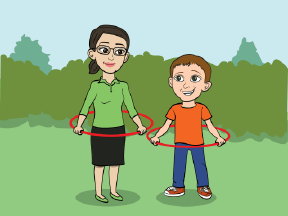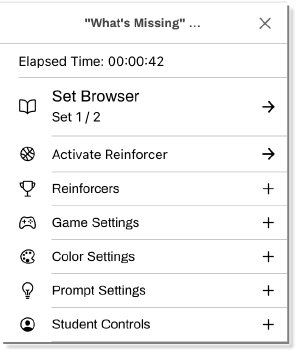Evidence-Based Practices

Evidence-based practices are a vital consideration when designing therapies and interventions. This is especially true when it comes to the design of computer-based solutions.
Many features within Speech Kingdom were created considering evidence-based and other interdisciplinary approaches that are widely considered to be highly effective, including
- Social Narratives (stories)
- Prompting
- Modeling
- Repetition
- Differential Reinforcement
(customized rewards) - Adjustment of Visuals (color vs grayscale)
- Auditory Speeds
- Flexible Sizing of answer banks
It is important to note that the above list is not meant to be exhaustive, but is presented to provide insight into the functionality requirements for an effective computer based social communication tool.
Further guidance and related information was and continues to be provided by licensed professionals, including psychologists, special education teachers, educational therapists, speech language pathologists (SLPs), occupational therapists (OTs), and other professionals.
Unique Design and Customization

Speech Kingdom's design required a level of customization for each social story, fundamental
skills mini-story and game that was previously unavailable from any other source. These design
requirements are necessary for the app to be effectively used across multiple settings,
including home, schools, and a variety of therapy sessions.
Emerging studies
provide overwhelming evidence that, by placing the student in various social situations (e.g.
social stories and social skills mini-stories), markedly increases the effectiveness of those
therapies, for communication, language, cognition, and behavioral learning.
Links to Supporting Studies

- National Autism Center's National Standards Project on Autism Spectrum Disorder (ASD, 2009)
- National Autism Center's National Standards Project on Autism Spectrum Disorder (ASD, 2015)
- An Educator's Manual to Evidence-based Practice and Autism, 2nd Edition
- A Parent's Guide to Evidence-based Practice and Autism
- National Professional Development Center on ASD (NPDC, 2010, 2014)
Additional Supporting Articles
- Alexander, P.A. (2004). A model of domain learning: Reinterpreting expertise as a multidimensional, multistage process. In D. Yun Dai & R.J. Sternberg (Eds.), Motivation, emotion, and cognition: Integrative perspectives on intellectual functioning and development (pp. 273-299). Mahwah, NJ: Erlbaum.
- Carr, E.G., Levin, L., McConnachie, G., Carlson, J., Kemp, D., & Smith, C. (1994). Communication based intervention for problem behavior: A user’s guide for producing positive change. Baltimore, MD: Brookes.
- Chin, H.Y., & Bernard-Optiz, V. (2000). Teaching Conversational skills to children with autism: Effect on the development of the theory of mind. Journal of Autism and Developmental Disorders, 30(6), 569-583. Doi: 10.1023/A: 1005639427185
- Collet-Klingenberg,L., & Franzone, E. (2008). Overview of social narratives: Madison: University of Wisconsin, Waisman Center. The National Professional Development Center on Autism Spectrum Disorders.
- Delano, M., & Snell, M.E. (2006). The effects of social stories on the social engagement of children with autism. Journal of Positive Behavior Interventions, 8(1), 29-42. Doi: 10.1177 ⁄ 10983007060080010501
- Gaskins, I.W. (2008). Developing cognitive flexibility in word reading among beginning and struggling readers. In K.B. Cartwright (Ed.), Literary Processes: Cognitive flexibility in learning and teaching (pp. 90-114). New York: Guilford Press.
- Gray, C.A. & Garand, J.D. (1993). Social Stories: Improving responses of students with autism with accurate social information. Focus on Autistic Behavior, 8(1), 1-10
- Greenspan, S. I., & Wieder, S. (1998). The child with special needs: Encouraging intellectual and emotional growth. Reading, MA: Addison Wesley.
- Hodgdon, L. (1995). Visual strategies for improving communication. Troy, MI: Quick Roberts Publishing.
- LeBlanc, L.A., Coates, A.M. Daneshvar, S., Charlop-Christy, M.H., Morris, C., & Lancaster, B.M. (2003). Using video modeling and reinforcement to teach perspective-taking skills to children with autism. Journal of Applied Behavior Analysis, 36(2), 253-257.
- Lorimer, P.A., Simpson, R.L., Myles, B.S., & Ganz, J.B. (2002). The use of social stories as a preventative behavioral intervention in a home setting with a child with autism. Journal of Positive Behavior Interventions, 4(1), 53-60. Doi: 10.1177 ⁄ 109830070200400109
- Mueller, M.M., Palkovic, C.M., & Maynard, C.S. (2007), Errorless learning: review and practical application for teaching children with pervasive developmental disorders. Psychology in the schools, 44, 691-700.
- National Research Council. (2001). Educating children with autism. Committee on Educational Interventions for Children with Autism. Division of Behavioral and Social Sciences and Education. Washington, DC: National Academy Press.
- National Institute of Child Health and Human Development. (2000). Report of the National Reading Panel: An evidence-based assessment of the scientific research literature on reading and its implications for reading instruction (NIH Publication No. 00-4769). Washington, DC: U.S. Government Printing Office.
- Odom, S.L., Cox A., Brock, M. @2013). Implementation Science, professional development, and autism spectrum disorders: National Professional Development Center on ASD.
- Ozonoff, S., & Miller, J.N. (1995). Teaching theory of mind: A new approach to social skills training for individuals with autism. Journal of Autism and Developmental Disorders, 25(4), 415-433. Doi: 10.1007 / BF02179376
- Prizant, B.M., &Wetherby, A. M., &Rydell, P. (2000). Communication intervention issues for children with autism spectrum disorders. In A. Wetherby & B. Prizant (Eds.), Autism spectrum disorders: A transactional approach developmental perspective (Vol. 9, pp. 193-224). Baltimore, MD: Brookes.
- Rogers, S.J. (2000). Interventions that facilitate socialization in children with autism. Journal of Autism and Developmental Disorders. 30(5), 399-409.
- Sansosti, F.J., Powell-Smith, K.A., & Kincaid, D. (2004). A research synthesis of Social Story interventions for children with autism spectrum disorders. Focus on Autism and Other Developmental Disabilities, 19(4), 194-204.
- Thiemann, K.S., & Goldstein, H. (2001). Social Stories, written text cues, and video feedback: Effects on social communication of children with autism. Journal of Applied Behavior Analysis, 34(4), 425-446.
- Tiger, C (2003) How to Behave: A guide to modern manners for the socially challenged. Philadelphia, PA Quirk Books
- Whalen, C., Liden, L., Ingersoll. B., Dallaire, E., & Liden, S. (2006). Positive behavioral changes associated with the use of computer assisted instruction for young children. Journal of Speech and Language Pathology and Applied Behavior Analysis, 1, 11-26.
- Wong, C., Odom, S. L. Hume, K. Cox, A. W., Fettig, A. Kucharczyk, S., Schultz, T.R. (2013). Evidence-based practices for children, youth, and adults with Autism Spectrum Disorder. Chapel Hill: The University of North Carolina, Frank Porter Graham Child Development Institute, Autism Evidence-Based Practices review Group.
- Wong, C. (2014). Social narratives (SN) fact sheet. Chapel Hill: The University of North Carolina, Frank Porter Graham Child Development Institute, The National Professional Development Center on Autism Spectrum Disorders
- Zins, J.E., Weissberg, R.P., Wang, M.C., & Walberg, H.J. (Eds.) (2004). Building academic success on social and emotional learning: What does the research say? New York: Teachers College Press.

